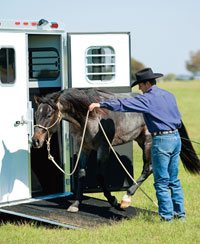
To help your horse overcome his trailering fears, you have to look at it from his perspective. As prey animals, with a flight or fight response, horses prefer to be in big, open spaces where they can easily see predators approaching them and make a quick getaway. You’ll never see a prey animal having a rest in a tight, narrow space because if a predator came along, he’d be trapped. That’s why, as a general rule, horses don’t like trailers—they make horses feel trapped and claustrophobic.
If you put yourself in your horse’s shoes, you’ll see that trailering can be a traumatic experience, especially when the horse doesn’t understand that the trailer isn’t going to hurt him.
One Step at a Time
When you begin to teach your horse to load onto the trailer, the first rule is to completely forget about the trailer. Act like loading your horse onto the trailer is the furthest thing from your mind because the more you think about getting him on the trailer, the more you’ll start to act like a predator and scare him.
Make sure your horse is comfortable around the trailer. If he’s not, he won’t want to get inside of it. Start by asking him to move his feet with energy around all three sides of the trailer. I use my Sending Exercise (making the horse move from one side of my body to the other), but as long as you make your horse hustle his feet, you’ll be in good shape.
When your horse is comfortable moving around the trailer (he’s not spooking at it), lower the trailer’s ramp and send him back and forth across it. This will help him get used to the noise the trailer will make when he steps up onto it. Anytime he wants to stop and smell the trailer or paw at the ramp, let him. That’s his way of doing his own safety inspection and proving to himself that the trailer isn’t going to harm him.
When your horse is calmly walking back and forth across the ramp of the trailer, ask him to take one step inside the trailer. And just before he gets nervous or plants his feet and refuses to move, back him out. You’ll play a little bit of a cat and mouse game with him. That’s the complete opposite of what he expects you to do; he thinks you’re going to force him on the trailer. But you’re going to make it his idea to get on the trailer by pretending you don’t even want him in there. Each time he steps inside it and you back him out and he doesn’t get hurt, he’ll gain more confidence.
When he’s comfortable taking one step inside the trailer, ask him to take two steps, and then back him out again. Keep working on that until his whole body is in the trailer. Then let him rest in the trailer for a few minutes as a reward.
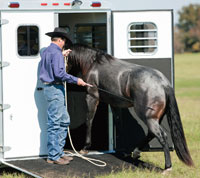
Craving the Trailer
Once your horse is over his fear of the trailer, you can work on getting him to “crave” the trailer—thinking that it’s the best place in the world. This technique not only works for getting your horse to willingly load onto the trailer, but it can also be used if you have a horse that kicks, paws or gets nervous in the trailer. Horses develop all of these problems because they’d rather be outside the trailer than feeling like they’re trapped inside of it.
By using a little reverse psychology, you’re going to show your horse that there’s no reason to get nervous or cop an attitude when he’s in the trailer because it’s the best place to be—he gets to relax in it. On the other hand, being outside the trailer means nothing but hard work and sweat. Since horses are basically lazy creatures, they’ll always choose the option with the least amount of work involved; it won’t take your horse long to catch on to the lesson.
Outside of the trailer, put your horse’s feet to work. I prefer to use my Lunging for Respect Stage Two exercise and the Sending Exercise near the trailer (see videos at HorseChannel.com/Extras), but as long as you make your horse hustle and work hard, you’ll accomplish the same goal. Keep in mind that this exercise only works if you really make your horse hustle his feet outside of the trailer. You have to give him a reason to want to be in the trailer.
After working your horse for several minutes, give him the opportunity to rest in the trailer. At this point, his most valuable commodity is air. You’re showing him that the only place he gets to rest and catch his breath is inside the trailer. Try to let him rest anywhere from five to 10 minutes in the trailer so that he has a chance to relax and think about the lesson.
After repeating this process several times in a row, you’ll notice that your horse will back off the trailer slower each time because he knows that once he’s outside the trailer he’ll have to work hard. Eventually, you’ll have to practically beg him to step off the trailer—what I consider a good problem to have.
The secret to getting a horse to calmly and confidently load onto a trailer is nothing more than understanding how he thinks, and making the right thing easy (stepping onto the trailer) and the wrong thing difficult (refusing to load).
Further Reading
Clinton Anderson Training Essentials
Trailer Training Psychology
On Board with Clinton Anderson
Clinician Clinton Anderson owns and operates Downunder Horsemanship in Stephenville, Texas, where his method of horsemanship has helped to transform the relationship between thousands of horses and riders. He also hosts two training programs that air weekly on Fox Sports Net and RFD-TV. www.downunderhorsemanship.com
This article originally appeared in the Decmber 2011 issue of Horse Illustrated. Click here to subscribe.

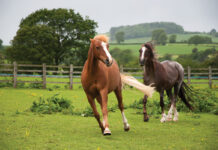
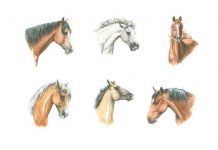
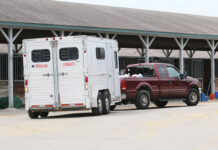

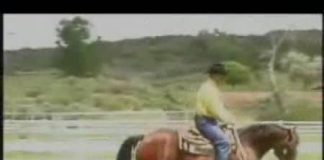

I can get my gelding to give in the straight load, as soon as there is movement behind him to put the button bar up, he will push out. I have a ramp so I have to get the bar on. I lunge him and he will come into the trailer either way, have let him stand in the trailer without pressure and still not happening.